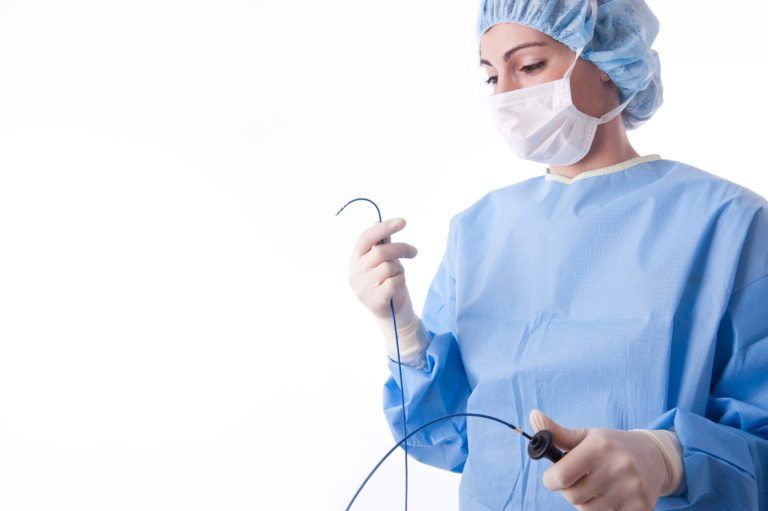Radiofrequency Ablation (RFA) Therapy

Radiofrequency ablation (RFA) therapy has been shown to be safe and effective for treating Barrett’s esophagus. Radiofrequency energy (radio waves) is delivered via a catheter to the esophagus to remove diseased tissue while minimizing injury to healthy esophagus tissue. This is called ablation, which means the removal or destruction of abnormal tissue.
While you are sedated, a device is inserted through the mouth into the esophagus and used to deliver a controlled level of energy and power to remove a thin layer of diseased tissue. Less than one second of energy removes tissue to a depth of about one millimeter. The ability to provide a controlled amount of heat to diseased tissue is one mechanism by which this therapy has a lower rate of complications than other forms of ablation therapy.
Larger areas of Barrett’s tissue are treated with the balloon-mounted catheter. Smaller areas are treated with the endoscope-mounted catheter. Both are introduced during an upper endoscopy procedure, which is a thin, flexible tube inserted through a patient’s mouth.
Clinical studies have demonstrated the Barrett’s esophagus tissue can be completely eliminated with the Barrx™ radiofrequency ablation system in over 90% of patients.
Am I a Candidate
First, talk it over with your doctor, who will have the most current information on the latest recommendations and guidelines for ablation therapy for Barrett’s esophagus.
You may be a candidate for RFA if you have Barrett’s esophagus and if your physician agrees that your stage of disease warrants therapy.
What to Expect
Before the procedure
Follow the instructions provided by your doctor or the nursing staff. The following instructions were provided to patients in clinical trials and are provided here as an example of what you can expect:
- No eating or drinking after midnight the day before the procedure.
- Arrange to have someone drive you home after the procedure.
- If you take aspirin or blood thinning medication, you will receive instructions from your doctor about when to stop taking them before each endoscopy.
The day of the procedure
The RFA treatment is usually performed in an outpatient setting and no incisions are involved. While the actual procedure time in clinical studies has been less than 30 minutes, there is preparation required prior to the procedure, and you will be monitored for a time afterwards.
After the Procedure
It is very important that you follow the discharge instructions provided by your doctor or the nursing staff. There are steps you must take to ensure a favorable outcome and to manage your acid reflux. Your doctor will help you:
- understand possible symptoms that may arise as a result of your treatment and how to treat those symptoms;
- evaluate your response to the therapy;
- monitor results over time.
Symptoms after treatment
You may experience chest discomfort, pain, and difficulty swallowing for several days after the procedure. These symptoms can all be managed with medications and will usually go away within three or four days.
Your doctor will prescribe antacid medications to help the healing of the esophagus. For most people, healthy tissue replaces the diseased tissue within three or four weeks.
If you seek care for a digestive issue from any other healthcare provider in the six months following the procedure, the doctor who did the RFA procedure should be consulted.
Contact your physician immediately if you experience any of the following:
- Significant chest pain
- Difficulty swallowing
- Fever
- Bleeding
- Abdominal pain
- Difficulty breathing
- Vomiting
- Other warning signs provided by the treating physician
Follow-up
After your RFA treatment, your doctor will schedule a follow-up appointment within two to three months to evaluate your progress. If any remaining Barrett’s tissue is found, additional therapy may be recommended. Clinical studies have demonstrated that Barrett’s tissue can be eliminated with RFA in more than 98% of patients.
Monitoring
Regular monitoring of people diagnosed with Barrett’s esophagus is recommended even after RFA therapy. This includes having an upper endoscopy with biopsies on a regular basis for the rest of your life. Your doctor will determine how often you should be evaluated based on the kind of Barrett’s esophagus you had.
Acid reflux treatment
Successful elimination of the Barrett’s esophagus tissue does not cure the acid reflux or GERD that caused Barrett’s. Your doctor will determine how to best manage your long-term acid reflux therapy.
To learn more about Barrett’s esophagus go to: learnaboutbarretts.com
DISCLAIMER: This information is intended only to provide general information and not as a definitive basis for diagnosis or treatment in any particular case. It is very important that you consult your doctor about your specific condition, contraindications, and possible complications. This treatment is contraindicated in patients who are pregnant, have had prior radiation therapy to the esophagus, esophageal varices at risk for bleeding, or prior Heller myotomy. Possible complications may include: mucosal laceration, perforation of the esophagus requiring surgery, infection, bleeding, and stricture formation requiring dilation. The overall complication rate reported for this procedure is approximately <.02%.


